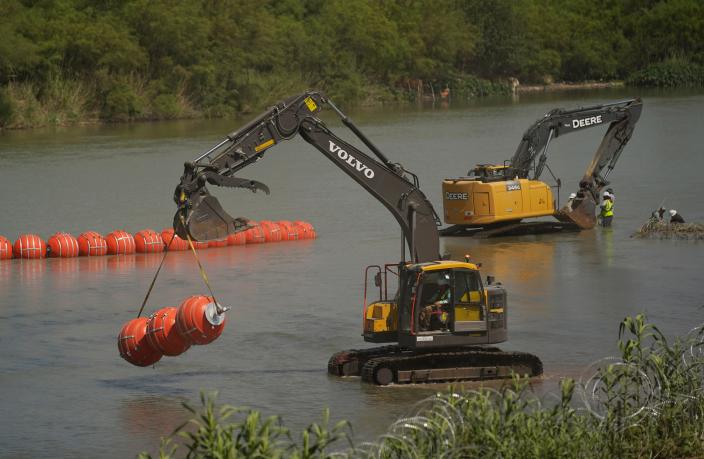
U.S. Rep. Veronica Escobar is criticizing a move by Gov. Greg Abbott to deploy a floating barrier in the Rio Grande as a “dangerous stunt” that will endanger migrants at the U.S.-Mexico border.
The El Paso Democrat sent a letter, alongside seven other Texas congressional Democrats, to U.S. Attorney General Merrick Garland and Secretary of State Antony Blinken stating that Abbott’s aquatic barrier along the river border in Eagle Pass, Texas, is a potential violation of international law.

Migrants who crossed the Rio Grande from Mexico on Wednesday walk past large buoys being deployed as a border barrier on the river in Eagle Pass.
“Gov. Abbott’s installation of floating barriers in the Rio Grande to deter migrant crossings is yet another dangerous stunt that prioritizes political posturing over the safety and well-being of both Texans and migrants,” the lawmakers wrote in the letter. “Instead of notifying and collaborating with the appropriate federal agencies — such as the International Boundary and Water Commission, the U.S. Army Corps of Engineers, and the Department of Homeland Security — Gov. Abbott continues to undermine the federal government by misusing state resources to interfere with federal immigration and security responsibilities.
“Gov. Abbott is not only wasting taxpayer dollars with these stunts … he is once again choosing inhumane and dangerous practices that intimidate, endanger, and hurt migrants and their families and put CBP personnel at risk.”

U.S. Rep. Veronica Escobar holds a news conference with presidential Senior Adviser Mitch Landrieu on July 8 at the Blue Flame Building in Downtown El Paso.
The letter states that the first segment of the barrier, being installed in Eagle Pass, is expected to cost $1 million.
“We urge the DOJ and DOS to take immediate action regarding this matter and the potential violations and obstructionism,” the letter states.
The Democrats’ letter did not appear to dampen the three-term Republican governor’s enthusiasm for the recent initiative at the Texas-Mexico border. On Friday, Abbott told the local press that the buoys will “bolster” measures that have long been in use.
“In addition to (razor wire), we now have buoys in the water to prevent people from even crossing the middle part of the Rio Grande River and coming into the state of Texas,” he told the cable outlet. “Because Texas has done such a prolific job of stopping people from coming into our state, you are seeing a massive increase in the number of people crossing into New Mexico, Arizona, and California.”
Will the barrier extend across the entire Rio Grande in Texas?
Abbott announced his plan to install an aquatic barrier along the border on June 8 following the Texas Legislature’s passage of a series of border security measures.
The buoys are currently being deployed in 1,000-foot segments in high-traffic areas along the Rio Grande rather than across the entire expanse of the 1,885-mile river in Texas.
“We can put mile after mile after mile of these buoys,” Abbott said during the news conference last month. “What we’re doing right now is we’re securing the border at the border. What the buoys will allow us to do is to prevent people from even getting to the border.”
The large string of orange balls will be attached to the riverbed and secured with netting below to ensure people do not attempt to swim under them. Additionally, the oversized buoys rotate, which has the effect of keeping people from trying to climb over.
Smugglers have historically found creative ways around border barriers, throwing rope ladders over 30-foot fencing and cutting windows in steel mesh.

Source: OEM





